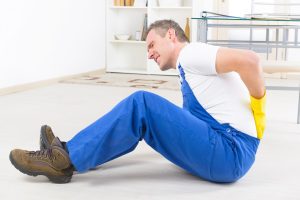Last Updated On 10th November 2025. If you’ve suffered a back injury at work, you could be entitled to claim compensation. However, you will need to prove that employer negligence occurred. This means that you will need supporting evidence that shows your employer did not comply with relevant health and safety regulations, thereby causing you to suffer a back injury.
Here at Accident Claims, we can help you with this. If you contact one of our friendly advisors, they will assess whether you have a valid accident at work claim. Your free consultation will look at whether you are within the 3 year time limit to start a claim, advise on evidence and provide a free estimate of how much compensation you could claim. Furthermore, if you meet the eligibility, one of our No Win No Fee solicitors could help with your claim.
Key Takeaways
- All employers must comply with relevant health and safety laws. If they fail to adhere to these laws and you suffer an injury as a result, then employer negligence has occurred.
- You may be able to make a personal injury claim against your employer. However, for any claim to be valid, it must meet specific eligibility criteria.
- A settlement for a back injury claim may consist of up to two heads to compensate you for your pain and suffering caused by the accident as well as any financial losses caused by the injury.
- A No Win No Fee solicitor can help prove your workplace accident claim as well as ensure that you are seeking the compensation amount relevant to your circumstances with all damages considered.
Contact Us
The friendly, knowledgeable advisors from our team are available around the clock to answer your questions about making a claim against your employer. As part of the free services on offer, they can assess your claim and if it seems valid, connect you to one of our No Win No Fee solicitors. To speak to us today:
- Call us on 0800 073 8801
- Start a live chat with one of our helpful team
- Or you can contact us online
Jump To A Section
- Can I Make A Back Injury At Work Compensation Claim?
- I Don’t Think My Injury Is Severe, Can I Still Claim For Damages?
- Causes Of Back Injuries In The Workplace?
- How Much Compensation Could I Get For My Back Injury At Work Claim?
- Can I Also Claim For Financial Losses Caused By My Injury?
- Will My Employer Have To Pay For My Compensation?
- What Do I Need In Order To Make A Back Injury At Work Claim?
- Example Case Study – Successful Back Injury At Work Claim
- How Can Accident Claims’ Solicitors Help Me?
- Frequently Asked Questions
- Learn More
Can I Make A Back Injury At Work Compensation Claim?
In order for you to be entitled to claim compensation for a back injury you suffered at work, it must first be established that employer negligence occurred. To prove negligence, there must be three elements:
- A duty of care was owed to you. A duty of care is a legal obligation placed on a liable party to ensure that they’ve taken reasonable care to avoid causing some form of foreseeable harm or injury.
- This duty was breached,
- As a result, you suffered an injury.
A duty of care is owed to employees by their employers, as per the Health and Safety at Work etc. Act 1974 . This means that your employer must take all reasonably practicable steps to ensure your health and safety while you carry out your job duties. To ensure compliance, your employer is responsible for assessing any risks. Follwing on from this, they need to take all reasonable protective measures to prevent workplace accidents, such as providing you with appropriate manual handling training.
Speak to a member of the advisory team to find out if you could have a valid back injury at work claim. As part of your free consultation, they can assess your grounds for claiming compensation.

I Don’t Think My Injury Is Severe, Can I Still Claim For Damages?
Regardless of the severity of the injury suffered, you may still be able to claim compensation if it happened as a result of your employer’s failure to comply with health and safety laws. The eligibility criteria is the same regardless of injury severity, or how many injuries you suffered in the same accident. For example, you may have suffered a minor back injury but the accident also caused a moderate mental health injury. Both of these injuries could be claimed for.
Furthermore, your injury itself may not seem severe, although the effects suffered as a result of your injury may be life-altering. For example, if you have sustained a back injury at work, which has meant that your ability to walk has been affected, this will impact your quality of life. You may even need to purchase a wheelchair, the cost of which could be recovered as part of a personal injury claim.
Each personal injury claim is different and based on the individual circumstances. Therefore, the amount of compensation you may be eligible for can vary depending on the severity of the injury. The Judicial College Guidelines (JCG) outline brackets of potential compensation, which we refer to later in our guide.
Please contact one of our team members today to see whether your injury could be eligible for a claim.

Causes Of Back Injuries In The Workplace?
There are a number of reasons why you may have suffered a back injury whilst at work; below are a few examples taken from the governmental watchdog of the Health and Safety Executive (HSE):
- Manual handling, if your employer has asked you to carry goods and has not given you any training on how to safely handle goods you could suffer a back injury.
- Slip, trip or fall; a back injuries can result from a fall from a height, if you have slipped on a wet floor or tripped over an uneven flooring.
- Impact injuries; for example if you were driving a forklift and crashed into a shelf.
This list is not exhaustive and back injuries can happen for many other reasons. If you are unsure whether your injury was at the fault of your employer, then please contact us today for further information.
Claiming As A Part-Time, Self-Employed, Zero Hour Contract Or Agency Worker
The Health and Safety at Work Act outlines the duty of care owed to any part-time, self-employed or agency worker. It states that persons not in employment, who may be affected thereby, should not be exposed to risks to their health or safety. What this means is that if you are carrying out work duties in that workplace, in whatever capacity, you are owed the same duty of care as that owed to employees, regardless of the specifics of your contract.
How Would Being Partially At Fault For My Accident Impact My Claim?
If you are partially responsible for the back injury you suffered at work, you may still be eligible for a claim. This is dependent on your level of fault; for example, if your employer took all reasonable steps to ensure you did not injure yourself, then you may not be entitled to any compensation. Whereas, if your employer is responsible for any degree of the injury suffered, you may still be entitled to compensation.
What this means is that the level of your involvement in the injury will directly affect the amount of damages you could be entitled to. For example, if you picked up an object despite being aware it was likely too heavy for you to manage on your own, you could be found 50% responsible. This would reduce your compensation by 50%.
If you are still unsure whether you have the basis for a claim, please contact our helpful team today to see how we can help!

How Much Compensation Could I Get For My Back Injury At Work Claim?
As stated earlier in this guide, all personal injury claims are valued based on their own merits. A settlement for a successful back injury at work claim may consist of up to two heads of loss: general and special damages.
If your accident at work claim is successful, you will be awarded general damages to compensate for the physical pain and mental suffering caused by the accident. The amount of damages you could be entitled to, as previously mentioned, varies based on the severity of the injury that you have suffered.
Our table below uses figures from the JCG to help show you how general damages could be valued. No amount of compensation can ever be guaranteed, although the JCG outlines brackets of compensation you may be awarded. Please note that the top entry in this table is not from the JCG.
| Severity | Injury Notes | Guideline Amount |
|---|---|---|
| Multiple Severe Injuries and Special Damages | Financial losses and costs incurred from injury/Special Damages, such a lost wages and the cost of mobility aids. | £1,000,000+ |
| Tetraplegia/Quadriplegia | Highest award in this range would be in cases where physical pain is present, loss of daily independence, significant impact on brain function, lack of awareness or a reduction in life expectancy. | £396,140 to £493,000 |
| Paraplegia | Potential award figures are based on the extent of ongoing pain, level of independence in normal daily tasks, life expectancy and age as well as any impact to sexual function. | £267,340 to £346,890 |
| Severe Back Injury (a)(i) | Includes paralysis or disability, serious injury resulting in a loss to bladder, sexual or bowel function. Damage to nerve endings or spinal cord, not typical cases of back injury and would usually be followed by severe pain. | £111,150 to £196,450 |
| Severe Back Injury (a)(ii) | Loss of sensation, restrictions to use of bowel, bladder or sexual function. Impaired mobility or serious scarring in injured areas. | £90,510 to £107,910 |
| Severe Back Injury (a)(iii) | Disc fractures, or soft-tissue injuries, where despite treatment, have led to chronic disabilities such as depression, severe and continuing pain, discomfort, unemployability, or arthritis. | £47,320 to £85,100 |
| Moderate Back Injury (b)(i) | This bracket covers injuries such as fractured vertebrae, or injuries causing a risk of osteoarthritis or spinal fusion. | £33,880 to £47,320 |
| Moderate Back Injury (b)(ii) | Ligaments or muscles causing backache, soft tissue injuries which have caused the worsening of a pre-existing condition. Also includes any treatments and the person's ability to function socially and recreationally. | £15,260 to £33,880 |
Can I Also Claim For Financial Losses Caused By My Injury?
Special damages are designed to compensate for any financial losses suffered as a result of your injury. This head of loss aims to put you in the position you were in before suffering the injury. Examples of special damages can include:
- Loss of earnings if you have to take time off work to recover.
- Loss of pension contributions, holiday accrual or bonuses.
- Medical expenses, such as prescriptions or paid for procedures.
- Home alterations, such as wetrooms, ramps or lifts.
- Childcare costs, if the injury has meant you need further support in childcare.
Would I Be Entitled To Interim Payments?
For an interim payment, you would have to apply through court and they are responsible for the approval. If you receive an interim payment, this amount will be deducted from your final compensation payout. Interim payments can help you with any immediate costs, such as wheelchairs or carers, mortgage payments, rent payments, and a range of other situations.
Please contact our advisors today to see how we can help.
Will My Employer Have To Pay For My Compensation?
You may worry about where your compensation is coming from, especially if you work in a small business or have a close relationship with your employer. Legally, each employer must have an Employers’ Liability Insurance policy in place. This ensures that an employer is able to pay compensation for any injuries suffered by their employees. All Employer’s Liability Insurance must cover at least £5 million.
What Do I Need In Order To Make A Back Injury At Work Claim?
In order to make a claim, you will need evidence that negligence has occurred. Evidence can be in the following forms:
- Medical receipts for any prescriptions
- X-rays or scanned images of your back injury
- Financial records such as bank statements
- Workplace accident record book, which should contain information about your injury
- Contact details from anyone willing to provide a supporting statement later into the claims process
- Any videos of the accident as it happened
In addition to ensuring that you have compelling evidence, you must also make sure you start the claims process within the time limit. For cases of personal injury, the Limitations Act 1980 outlines that you have 3 years from the date of the injury to start your claim. There are, however, exceptions to this rule, and if you have any questions about whether your time limit has passed, please contact us today to discuss.

Example Case Study – Successful Back Injury At Work Claim
In this example case study*, we look at how Mr K made a successful back injury at work claim and was awarded £26,000 in compensation.
Warehouse employee Mr K suffered an injury to his lower back while lifting heavy items without the proper manual handling training. A co-worker reported the injury to the supervisor. Mr K ensured that the incident was recorded in the accident book. He left work early and attended a medical appointment to have his injuries checked and recorded in his medical records.
After a few days, he had recovered enough to collect evidence and contact a solicitor. A solicitor agreed to take on his claim under a No Win No Fee arrangement. As Mr K had contact details for eyewitnesses to the accident, he was able to pass these on to his solicitor, who then collected witness statements.
Mr K was awarded £18,000 in general damages and £8,000 in special damages. The special damages included compensation for his lost wages for time signed out of work to recover, physiotherapy and travel expenses to his appointments.
Employers must ensure that their employees receive adequate safety training, even if they’ve worked in a similar role previously. Failing to do so can result in a successful compensation claim should an employee suffer preventable injuries.
To see if you may have an eligible accident at work claim, you can contact our advisors.
How Can Accident Claims’ Solicitors Help Me?
We are in partnership with a range of different specialists who can assist you through your recovery. For example, we work with occupational therapists, counsellors and disability specialists who can help you in your recovery. In addition to ensuring that you get specialist support, one of our solicitors will advise you on evidence, ensure your claim is accurately valued and manage any documentation needed.
Furthermore, our solicitors will do this without asking you to pay for the service upfront. This is because our expert solicitors operate on what is known as a No Win No Fee basis. This means that a solicitor will take on your case, with no upfront or ongoing payments for the work they put in on it. If successful, a success fee would be deducted from the compensation received. As per the Conditional Fee Agreements Order 2013, this percentage is capped. If your claim does not succeed, then you won’t be asked to pay for your solicitor’s work on it.
Contact Us
Our specialist solicitors are here to help you start your workplace accident claim, Speak to one of our advisors. They will value your claim, advise you on evidence, check to ensure that you are still within the limitation and if you satisfy the criteria, they could connect you to one of our solicitors.
- Call us on 0800 073 8801
- Start a live chat with one of our helpful team
- Or you can contact us online

Frequently Asked Questions
Are you still unsure? Please take a look at our FAQ’s.
Can I Make A Back Injury Claim If I Have A Pre-Exisiting Condition?
Yes, you are still able to make an injury claim if you have a pre-existing condition. However, this may impact the potential award you could be entitled to. For example, if your pre-exisiting condition has been worsened as a result of the workplace injury, you would only receive compensation for how the condition has worsened and not the original condition itself.
Please contact our solicitors today to see how we can help.
Will I Have To Attend A Medical As Part Of My Claim?
A medical examination will assess the level of your injuries and will be used as evidence to determine the amount of compensation you may be eligible for. We work in partnership with a range of different medical professionals who can assist you through this. Please contact us today for any further information.
How Long Until My Claim Is Settled And My Compensation Is Paid To Me?
The time it takes for a claim to be settled depends on many factors in the case, such as whether the claim gets taken to court, the complexity of your injury, evidence gathering and any treatments that you may need. Once settled, usually you would be paid compensation within 28 days.
Can I Be Penalised By My Employer For Making A Workplace Accident Claim?
While it may feel uncomfortable to make a claim against your employer, you have a legal right to start a claim which cannot be infringed by your employer.
Learn More
To learn more about making an accident at work claim:
- If you have suffered an injury caused by a broken ladder,
- If you were struck or hit by heavy boxes,
- If you have been injured by a colleague at work,
Or to learn more:
- Information on statutory sick pay,
- Knowing when to call 999,
- When to report injuries, diseases and dangerous occurrences.
*Please note that the example case study was included as an illustration.
Thank you for reading our guide on making a back injury at work claim.



